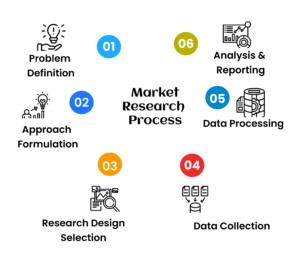Step-by-Step Guide to Market Research Guide
What is Market Research?
Market research examines consumer behavior and trends in the economy to help a business develop and fine-tune its business idea and strategy. It helps a business understand its target market by gathering and analyzing data.
Market research evaluates the viability of a new service or product through research conducted directly with potential customers. It allows a company to define its target market and get opinions and other feedback from consumers about their interest in a product or service.
Research may be conducted in-house or by a third party that specializes in market research. It can be done through surveys and focus groups, among other ways. Test subjects are usually compensated with product samples or a small stipend for their time.

How Market Research Works
Market research is used to determine the viability of a new product or service. The results may be used to revise the product design and fine-tune the strategy for introducing it to the public. This can include information gathered to determine market segmentation. It also informs product differentiation, which is used to tailor advertising.
A business engages in various tasks to complete the market research process. It gathers information based on the market sector being targeted by the product. This information is then analyzed and relevant data points are interpreted to conclude how the product may be optimally designed and marketed to the market segment for which it is intended.
Market research can be conducted in many different ways, including surveys, product testing, interviews, and focus groups.
Market research usually consists of a combination of Primary Market Research & Secondary Market Research
- Primary research, gathered by the company or by an outside company that it hires
- Secondary research, which draws on external sources of data
Primary Market Research
Primary research generally falls into two categories: exploratory and specific research.
- Exploratory research is less structured and functions via open-ended questions. The questions may be posed in a focus group setting, telephone interviews, or questionnaires. It results in questions or issues that the company needs to address about a product that it has under development.
- Specific research delves more deeply into the problems or issues identified in exploratory research.
Secondary Market Research
All market research is informed by the findings of other researchers about the needs and wants of consumers. Today, much of this research can be found online.
Secondary research can include population information from government census data, trade association research reports, polling results, and research from other businesses operating in the same market sector.
Types of Market Research
- Interviews
- Focus Groups
- Observation-Based Research
- Buyer Persona Research
- Market Segmentation Research
- Pricing Research
- Competitive Analysis Research
- Customer Satisfaction and Loyalty Research
- Brand Awareness Research
- Campaign Research
Six stages of the market research process?
Problem Definition
- Define the problem and research objectives. The first step in any marketing research study is to define the problem while taking into account the purpose of the study, the relevant background information, what information is needed, and how it will be used in decision-making.
- This stage involves discussion with the decision makers, interviews with industry experts, analysis of secondary data, and, perhaps, some qualitative research, such as focus groups.
Development of an Approach Formulation
- Step two includes formulating an objective or theoretical framework, analytical models, research questions, and hypotheses, and identifying characteristics or factors that can influence the research design.
- This process is guided by discussions with management and industry experts, case studies and simulations, analysis of secondary data, qualitative research, and pragmatic considerations.
Research Design Formulation
A research design is a framework or blueprint for conducting a marketing research project. It details the procedures necessary for obtaining the required information, and its purpose is to design a study that will test the hypotheses of interest, determine possible answers to the research questions, and provide the information needed for decision-making.
Data Collection Method
- Objectives, sample plans, analytical plans, and costs have the highest influence on which methods we use. Be open to using hybrid approaches combining qualitative and quantitative data collection methods
- Discuss which methods are the best fit to research the target pop. Some target groups may be difficult to reach with the same method
- If you decide on mixed-mode surveys, be aware of potential measurement errors each mode introduces. Check: Understanding the Pros and Cons of Mixed-Mode Research
- Once the data collection methods are selected, determine if you can do it with internal resources or need a research vendor.
Data Processing
- Clean your data. It doesn’t matter if it is quantitative or qualitative data, quality controls are needed.
- Fraudulent research participants are always trying to game the system to get their incentives. Try to catch them on the fly with the help of fraud prevention software and smart programming in recruitment screeners and question design and programming.
- Code open-ended questions to find patterns in the data.
- Create cross-tabulated tables to help organize the data if you do surveys.
- Transcribe interviews and focus group discussions to use tools to organize qualitative data to facilitate thematic analysis.
Analyze & Report
- Keep the key objectives in mind to connect market research to business impact. Check: How To Connect Market Research To Business Impact
- Share preliminary results with key stakeholders, discuss, and check if they make sense from a practical standpoint.
- Focus on the story behind the numbers and how they support your recommendations. Don’t do a data dump. Focus on insights.
How to do Market Research Online
Define Your Objectives:
Clearly outline the goals of your market research. Are you seeking customer feedback, analyzing competitors, or exploring new opportunities? Defining your objectives sets the foundation for a focused and effective research strategy.
Identify Your Target Audience:
Pinpointing your ideal audience is key. Utilize online tools and analytics to understand demographics, preferences, and behaviors. This data will shape your research parameters and ensure you gather relevant insights.
Utilize Online Surveys and Questionnaires:
Leverage online survey tools to collect quantitative and qualitative data. Craft targeted questions that align with your objectives. Platforms like SurveyMonkey and Google Forms make it easy to gather feedback from a wide audience.
Dive into Social Media Monitoring:
Tap into the vast pool of social media platforms to understand what people are saying about your brand, industry, or competitors. Social listening tools help you track mentions, sentiment, and emerging trends.
Analyze Competitor Strategies:
Explore your competitors’ online presence. What keywords are they targeting? What content are they producing? Tools like SEMrush or Ahrefs can provide valuable insights into competitor strategies, allowing you to identify gaps and opportunities.
Explore Google Trends:
Stay ahead of industry trends by utilizing Google Trends. Identify rising topics and keywords related to your business. This real-time data helps you align your strategies with current market demands.
Leverage Customer Reviews and Testimonials:
Online reviews are a goldmine of customer sentiment. Analyze reviews on platforms like Yelp, Google, and industry-specific sites to understand customer satisfaction, pain points, and expectations.
Monitor Website Analytics:
Dive into your website analytics to track user behavior. Identify popular pages, track conversion rates, and understand the customer journey. Google Analytics and other tools provide valuable data to refine your online strategy.
Stay Updated with Industry Reports:
Explore industry-specific reports and publications to gain a broader perspective. Many organizations and market research firms publish valuable insights and trends that can inform your decision-making.
Synthesize and Implement Findings:
Once you’ve gathered data, synthesize the findings into actionable insights. Develop strategies based on your research, and continuously iterate as the online landscape evolves.
Key Takeaways
- Companies conduct market research before introducing new products to determine their appeal to potential customers.
- Tools include focus groups, telephone interviews, and questionnaires.
- The market research results inform the product’s final design and determine how it will be positioned in the marketplace.
- Market research usually combines primary information, gathered directly from consumers, and secondary information, data available from external sources.


